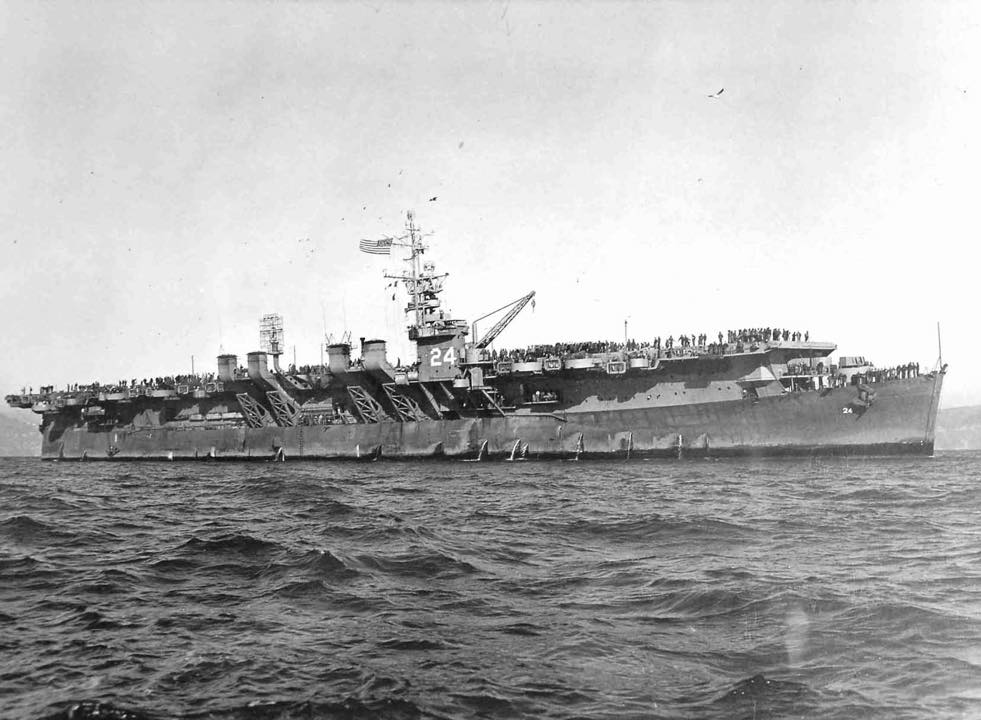
CVL-24: dp. 11,000; 1. 622'6"; b. 109'2"; dr. 26'; S.
31.6 k.; cpl. 1569; a. 26 40 mm.; cl. Independence)
New Haven (CL-76) was reclassified CV-24 and renamed Belleau Wood on 16 February 1942. She became CVL-24 on 15 July 1943. Belleau Wood was launched on 6 December 1942 by New York Shipbuilding Corp., Camden, N.J.; sponsored by Mrs. Thomas Holcomb, wife of the Commandant of the Marine Corps; and commissioned on 31 March 1943, with Captain A. M. Pride in command.
After a brief shakedown cruise, Belleau Wood reported to the Pacific Fleet, arriving at Pearl Harbor on 26 July 1943. After supporting the occupation of Baker Island (1 September) and taking part in the Tarawa (18 September) and Wake Island (5-6 October) raids, she joined TF 50 for the invasion of the Gilbert Islands (19 November-4 December 1943).
Belleau Wood operated with TF 58 during the seizure of Kwajalein and Majuro Atolls, Marshall Islands (29 January-3 February 1944); the Truk raid (16-17 February); the Saipan-Tinian-Rota-Guam raids (21-22 February); the Palau-Yap-Ulithi-Woleai raid (30 March-1 April); the Sawar and Wakde Island raids in support of the landings at Hollandia, New Guinea (22-24 April); the Truk-Satawan-Ponape raid (29 April-1 May); the occupation of Saipan (11-24 June); the 1st Bonins raid (15-16 June); the Battle of the Philippine Sea (19-20 June); and the 2nd Bonins raid (24 June). During the Battle of the Philippine Sea, Belleau Wood's planes sank the Japanese carrier Hiyo.
After an overhaul at Pearl Harbor (29 June-31 July 1944), Belleau Wood rejoined TF 58 for the last stages of the occupation of Guam (2-10 August). She joined TF 38 and took part in the strikes in support of the occupation of the southern Palaus (6 September-14 October); the Philippine Islands raids (9-24 September); the Morotai landings (15 September); the Okinawa raid (10 October); the northern Luzon and Formosa raids (11-14 October); the Luzon strikes (15 and 17-19 October); and the Battle of Cape Engano (24-26 October). On 30 October, while Belleau Wood was patrolling with her task group east of Leyte, she shot down a Japanese suicide plane which fell on her flight deck aft causing fires that set off ammunition. Before the holocaust could be brought under control, 92 men were killed or went missing.
After temporary repairs at Ulithi (2-11 November), Belleau Wood steamed to Hunter's Point, Calif., for permanent repairs and an overhaul, arriving on 29 November. She departed San Francisco Bay on 20 January 1945 and joined TF 58 at Ulithi on 7 February. During 15 February-4 March, she took part in the raids on Honshu Island, Japan, and the Nansei Shoto, as well as supporting the landings on Iwo Jima. She also took part in the 5th Fleet strikes against Japan (17 March-26 May) and the 3rd Fleet strikes (27 May-11 June). After embarking a new air group at Leyte (13 June-1 July), she rejoined the 3rd Fleet for the final strikes against the Japanese home islands (10 July-15 August).
Belleau Wood launched her planes on 2 September for the mass flight over Tokyo, Japan, during the surrender ceremonies. She remained in Japanese waters until 13 October. Arriving at Pearl Harbor on 28 October, she departed three days later with 1,248 servicemen for San Diego. She remained on "Magic Carpet" duty, returning servicemen from Guam and Saipan to San Diego, until 31 January 1946. During the next year, Belleau Wood was moored at various docks in the San Francisco area undergoing inactivation. She was placed out of commission in reserve at Alameda Naval Air Station on 13 January 1947. She remained in reserve until transferred to France on 5 September 1953 under the Mutual Defense Assistance Program.
Belleau Wood received the Presidential Unit Citation and 11 battle stars during World War II.
